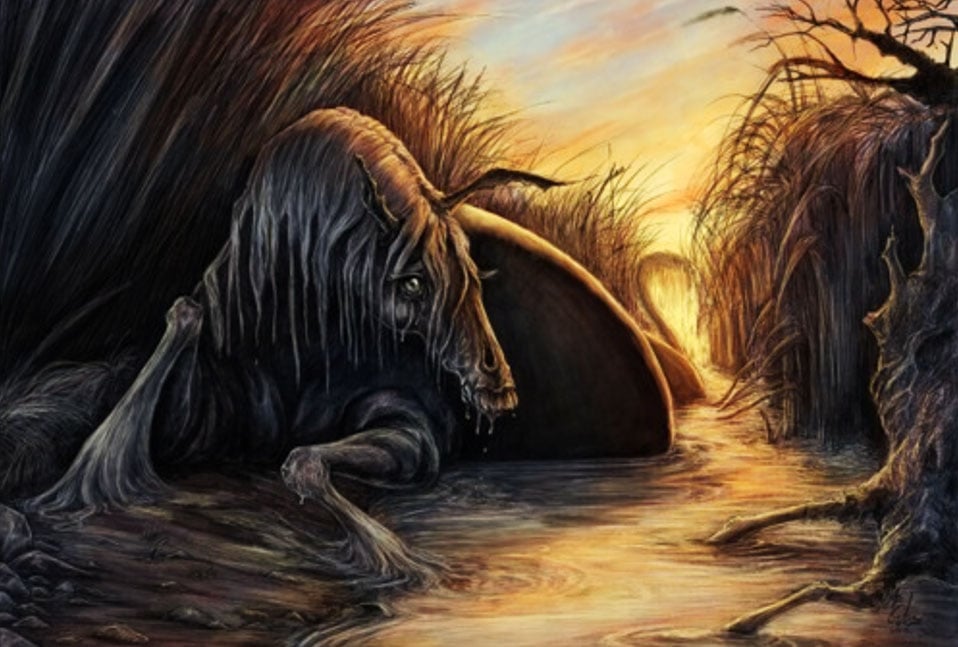Riding the Seas: Kelpies, Hippocampus, and More Monstrous Horses
There are many interesting legends from around the world and through the ages that refer to mythical beings that are similar to horses. The Scottish Kelpies are some of the more intriguing of these creatures and tales about these water horses have been told far and wide around that country. But before those creatures existed there was a sea horse in Greek myth that was known as a hippocampus.
Shape-shifting and Sacrifices to Water Spirits
In Scotland, the kelpie is a shape-shifting water spirit which resides in lakes and pools. The historian Douglas Harper defined kelpies as demons appearing specifically in the shape of horses. However, some legends say that it can also assume human form.
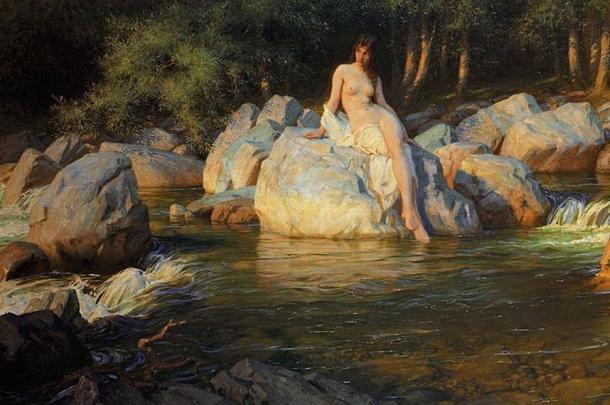
‘The Kelpie’ (1913) by Herbert James Draper. (Public Domain)
While appearing as a human, the kelpie will still have its hooves. For this reason, the kelpie is seen as a malefic entity. In Scotland, almost every lake has a story about a kelpie. Probably the most well-known of these stories is the one about the kelpie of Loch Ness.
In the past, human sacrifices were made to appease the gods and spirits of the waters. In time, this practice led to the appearance of the belief in evil water horses. There are some stories, however, in which kelpies are seen in a more positive light and are said to protect small children from drowning in lakes. Kelpies also apparently warned young women to be wary of handsome strangers.
- Horses as Symbols of Power in History and Mythology
- One of a Kind Ancient Tablet with Horse Racing Rules Unearthed in Turkey
- Truly Amazing Scientific Discovery on Adaptation of Yakutian Horses to Cold
Kelpies are the most common water spirits in Scottish folklore and they can live both in water as well as on land. They often appear in legends as strong and beautiful black horses which live in the deep pools of rivers and streams in Scotland.
Kelpies are known for preying on the humans they encounter. The hooves of the kelpie are thought to be reversed to those of a regular horse. In Aberdeenshire, the kelpie allegedly has a mane of serpents, while the kelpie of River Spey was known to be white and capable of singing.
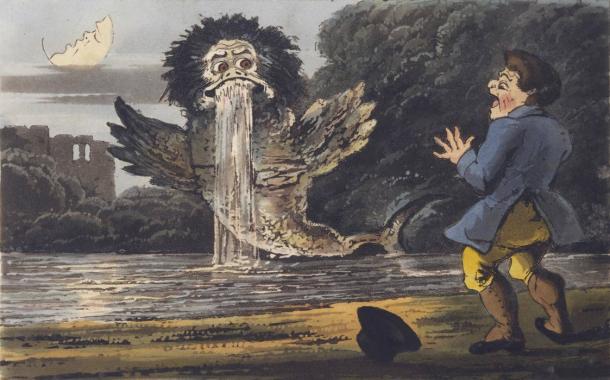
Kelpie Scares Man – Anon. (Archivist /Adobe Stock)
More Vicious Horse Beings
The tangie or tongie is another shape-shifting spirit from Orkney and the Shetland Isles. It is a sea spirit appearing in the form of a horse or as a merman. This spirit can also appear as an old man. The creature is said to be covered with seaweed and it allegedly loves to terrorize lonely travelers.
Specifically, the tangie has a predilection for young women, whom it allegedly will abduct and devour under water. Black Eric, a sheep rustler, was known in legends for riding a tangie. The tangie he rode offered him supernatural assistance while raiding surrounding crofts. Ultimately, Black Eric fell to his death in the sea - but his tangie continued to terrorize the area.
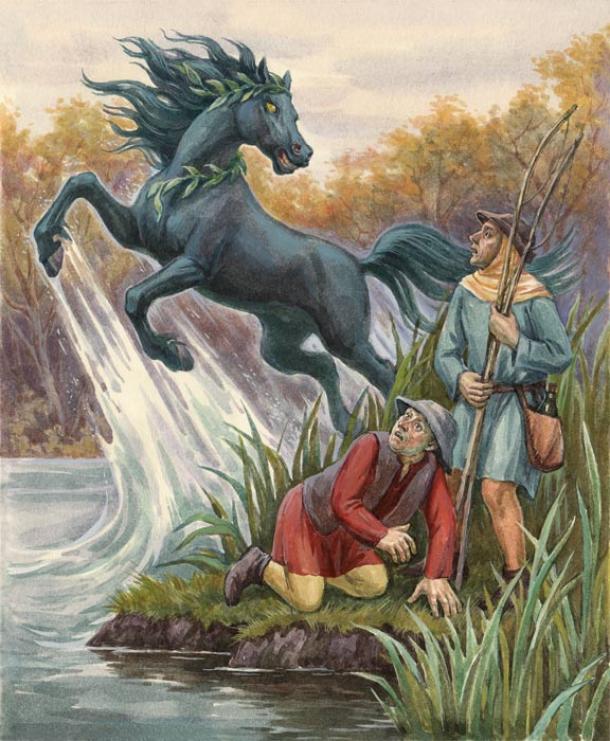
People in the Highlands were often wary of lone animals and strangers they encountered near the water’s edge. (natalia9 /Adobe Stock)
The each-uisge of Scotland is known as “Ech-Ushkya” or as the “each-uisce” in Ireland. Literally meaning “water horse” it is a water spirit resembling the kelpie, but is far more vicious. Folklorist Katharine Briggs described the mythical being as “perhaps the fiercest and most dangerous of all the water-horses”.
While the kelpie inhabits rivers and streams, the each-uisge lives in the sea and in lakes. It is a shape shifter disguised as a beautiful horse, a pony, a giant bird or as a handsome man. While it is in its horse form, should a person mount it, then the individual is only safe while the each-uisge is on land.
However, as soon as the horse smells water it is the end for the rider. The horse’s skin will become adhesive and the horse creature will immediately take its rider into the deepest part of the lake, drowning him. Once the victim has drowned, the each-uisge rips the corpse apart and devours it, leaving only the liver to float to the surface. For this reason, people in the Highlands were often wary of lone animals and strangers they encountered near the water’s edge.
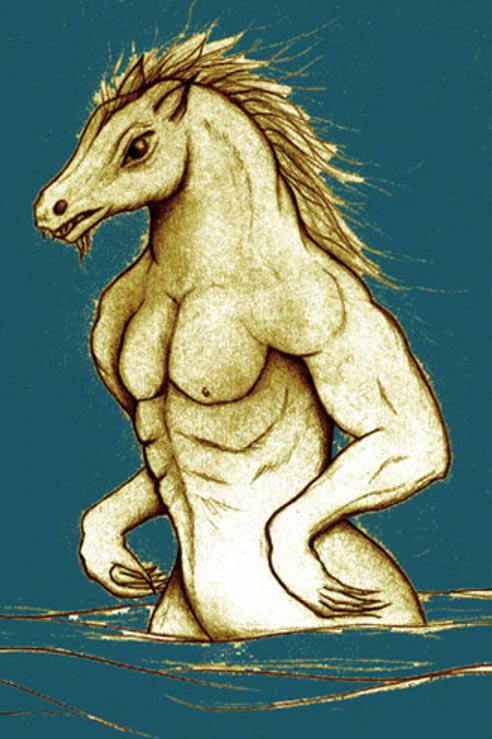
Representation of each-uisge, a supernatural water horse found in the lochs of Scotland. (Liza Phoenix /CC BY SA 3.0 )
On the Isle of Lewis, Croc-na-Beist, meaning “hillock of the monster”, is a knoll where an each-uisge was said to have been slain by the brother of a woman it tried to seduce while in its human form.
Apart from humans, these malevolent water creatures also fed on cattle and sheep. The use of these animals could also help someone to lure, capture, and kill the each-uisge. The smell of roasted meat attracts the each-uisge in McKay’s story from “ More West Highland Tales ”:
A blacksmith from Raasay lost his daughter to the each-uisge. In revenge the blacksmith and his son made a set of large hooks, in a forge they set up by the loch side. They then roasted a sheep and heated the hooks until they were red hot. At last a great mist appeared from the water and the each-uisge rose from the depths and seized the sheep. The blacksmith and his son rammed the red-hot hooks into its flesh and after a short struggle dispatched it. In the morning there was nothing left of the creature apart from a jelly like substance .
- The Mystery of the White Horse of Uffington
- The Tomb of Duke Jing of Qi and his 600 Horses
- Giddyap! How the Stirrup Revolutionized Horseback Riding and Helped Build Empires
Hippocampus and Other Ancient Horses
The hippocampus, meaning “horse monster” in Greek, is a mythical creature in Greek and Phoenician mythology. In English, the creature is often called a “sea-horse”. The being was also adopted by Etruscan mythology and it is described as having the upper body of a horse and the lower body of a fish.
Melquart, the tutelary god of the Phoenician city of Tyre, was depicted as riding a winged hippocampus. Poseidon was also the god of horses and known as Poseidon Hippios.
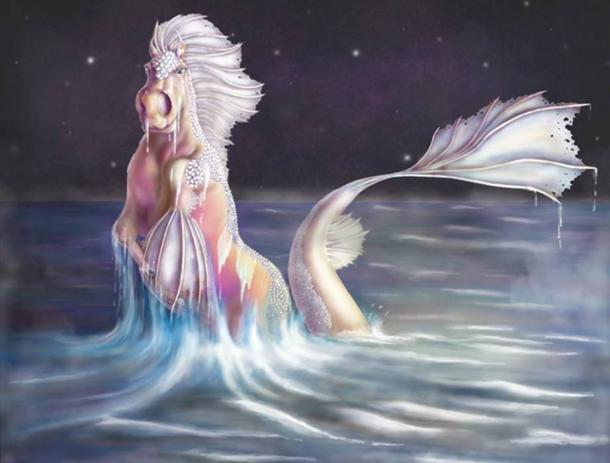
A representation of a mythical hippocampus (sea horse). (DiGiTAM/CC BY NC ND 2.0)
Even though it was not a water horse, Sleipnir of Norse mythology is also worth mentioning here. Sleipnir was believed to be the eight-legged steed of the chief god Odin, the child of Loki, and the fastest horse in all of the nine worlds.
Horses have been present since the beginning of human history and they have also entered the myths and legends of the world in a variety of forms – sometimes sweet, sometimes scary.
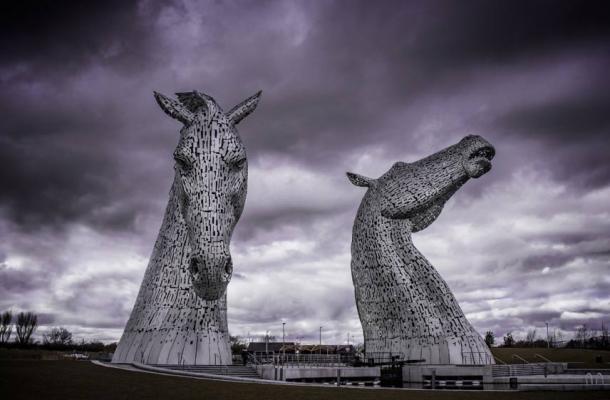
Sculptures of Kelpies in Falkirk. (CC BY SA 2.0)
Top Image: A representation of a kelpie, a sea horse more vicious than the hippocampus, in its true form. Source: CC BY SA
By Valda Roric
References:
Valda Roric – “From History to Mystery”
Valda Roric – “Loki – The Trickster Unleashed”
Valda Roric – “Loki – The Trickster Redeemed and the Secret of the Runes”
McKay – “More West Highland Tales”


















